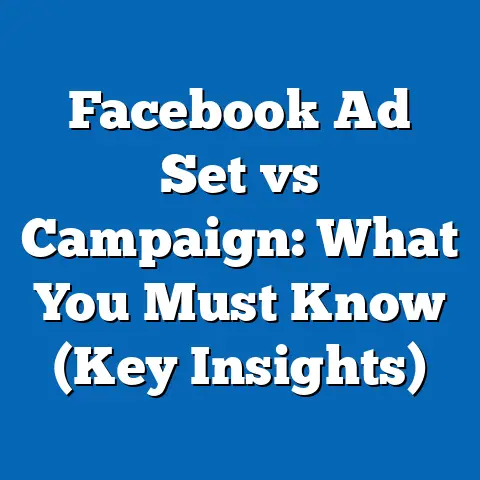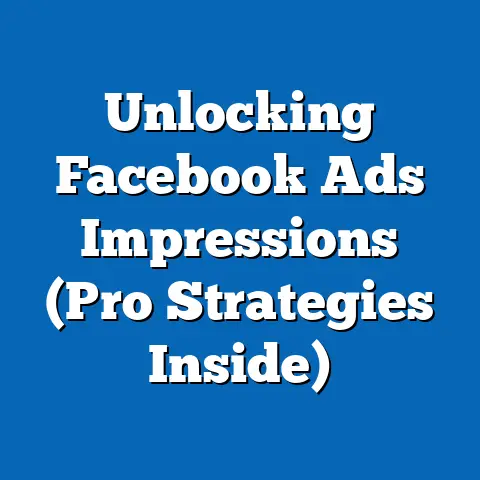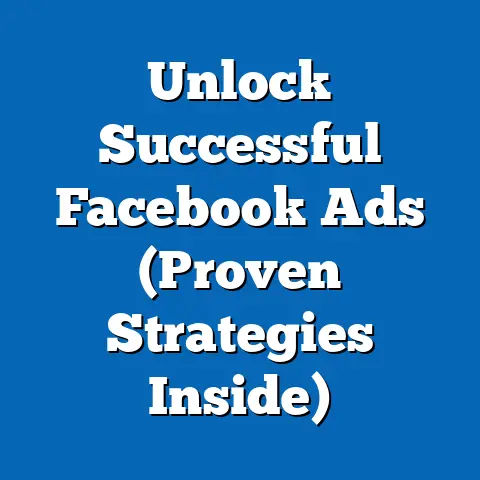Unlock Top Facebook Interests for Chiropractic Ads (Game Changer)
In today’s digital age, where attention spans are shorter than ever, first impressions are everything. Think about it – you’re scrolling through Facebook, bombarded with ads, articles, and updates from friends and family. What makes you stop and take notice? More often than not, it’s something that speaks directly to your interests, needs, or desires. This is especially true for chiropractic services, where trust and connection are paramount. A poorly targeted ad can not only waste your advertising budget but also damage your brand’s credibility. That’s why unlocking the power of Facebook interests is a game-changer for chiropractic practices looking to thrive in the digital landscape.
I remember when I first started helping local businesses with their Facebook advertising. A chiropractor came to me, frustrated that his ads were reaching the wrong people. He was essentially shouting into a crowded room, hoping someone would hear him. His budget was dwindling, and he was ready to give up on Facebook altogether. After diving deep into audience research and interest targeting, we completely revamped his campaigns. The results? A significant increase in appointment bookings, a lower cost per acquisition, and a much happier client. This experience solidified my belief in the power of targeted advertising, and I’m excited to share my insights with you in this article.
According to recent statistics, over 2 billion people use Facebook daily. That’s a massive audience, but it’s also a sea of noise. To cut through that noise, you need to be laser-focused on who you’re trying to reach. By understanding and leveraging the right Facebook interests, you can transform your chiropractic ads from generic messages into personalized invitations to better health and wellness. This article will guide you through the process of identifying, targeting, and optimizing your Facebook ad campaigns to attract the patients you need to grow your practice. Get ready to unlock the top Facebook interests for chiropractic ads and revolutionize your marketing strategy.
Section 1: Understanding Facebook Advertising Basics
Before we dive into the specifics of interest targeting, let’s cover some essential Facebook advertising basics. Think of Facebook advertising as a structured system, broken down into three main levels: campaigns, ad sets, and ads.
-
Campaigns: This is the highest level and represents your overall marketing objective. Are you trying to generate leads, drive traffic to your website, or increase brand awareness? Your campaign objective will influence the type of ad formats you use and the bidding strategies you employ. For example, if your goal is to get more appointments, you might choose the “Lead Generation” or “Conversions” objective.
-
Ad Sets: Within each campaign, you have ad sets. These are where you define your target audience, budget, and ad placement. This is where the magic of interest targeting happens. You can specify who you want to see your ads based on demographics, interests, behaviors, and more. You’ll also set your daily or lifetime budget for each ad set, as well as where you want your ads to appear (Facebook feed, Instagram feed, Audience Network, etc.).
-
Ads: Finally, we have the ads themselves. These are the creative elements that your target audience will actually see. This includes your ad copy, images, videos, and call-to-action buttons. It’s crucial to create compelling and relevant ads that resonate with the interests of your target audience.
Campaigns: This is the highest level and represents your overall marketing objective. Are you trying to generate leads, drive traffic to your website, or increase brand awareness? Your campaign objective will influence the type of ad formats you use and the bidding strategies you employ. For example, if your goal is to get more appointments, you might choose the “Lead Generation” or “Conversions” objective.
Ad Sets: Within each campaign, you have ad sets. These are where you define your target audience, budget, and ad placement. This is where the magic of interest targeting happens. You can specify who you want to see your ads based on demographics, interests, behaviors, and more. You’ll also set your daily or lifetime budget for each ad set, as well as where you want your ads to appear (Facebook feed, Instagram feed, Audience Network, etc.).
Ads: Finally, we have the ads themselves. These are the creative elements that your target audience will actually see. This includes your ad copy, images, videos, and call-to-action buttons. It’s crucial to create compelling and relevant ads that resonate with the interests of your target audience.
The Importance of Audience Targeting:
Imagine you’re selling running shoes. Would you advertise to everyone on Facebook, regardless of their interests? Of course not! You’d want to target people who are interested in running, fitness, or sports. The same principle applies to chiropractic services. You need to target people who are likely to be interested in your services, such as those with back pain, neck pain, headaches, or those seeking alternative health solutions.
Effective audience targeting is crucial for several reasons:
- Increased Relevance: By targeting the right people, you ensure that your ads are seen by those who are most likely to be interested in your services. This increases the chances of engagement and conversion.
- Reduced Costs: When you target a relevant audience, you’ll see a lower cost per click (CPC) and cost per acquisition (CPA). This is because Facebook rewards advertisers who show their ads to the right people.
- Improved ROI: Ultimately, effective audience targeting leads to a higher return on investment (ROI). You’ll get more value from your advertising budget by reaching the people who are most likely to become patients.
Understanding Interests as a Targeting Option:
Facebook offers a wide range of targeting options, including demographics, location, behaviors, and interests. Interests are based on the pages people have liked, the topics they’ve engaged with, and the information they’ve shared on Facebook.
Think of interests as a way to tap into the passions and preferences of your target audience. By targeting people who are interested in specific topics, you can reach them with ads that are highly relevant and engaging. For chiropractic ads, this means targeting people who are interested in health, wellness, fitness, and alternative medicine.
Takeaway: Facebook advertising is a powerful tool, but it’s only effective if you understand the basics. By focusing on audience targeting and leveraging the power of interests, you can reach the right people with the right message and achieve your marketing goals. Next, we’ll delve into understanding the chiropractic market landscape.
Section 2: The Chiropractic Market Landscape
Before you can effectively target your Facebook ads, it’s crucial to understand the chiropractic market landscape. This includes understanding market trends, consumer behavior, and the challenges faced by chiropractic practices in marketing and patient acquisition.
Overview of the Chiropractic Industry:
The chiropractic industry is a growing market, driven by an increasing awareness of the benefits of alternative medicine and a desire for non-invasive pain management solutions. According to recent reports, the global chiropractic market is expected to reach [Insert Statistic Here] by [Insert Year Here].
Here are some key trends shaping the chiropractic industry:
- Growing Demand for Natural Healthcare: More and more people are seeking natural and holistic approaches to healthcare, leading to increased demand for chiropractic services.
- Aging Population: As the population ages, there’s a greater need for pain management solutions, particularly for age-related conditions like arthritis and back pain.
- Increased Awareness of the Benefits of Chiropractic: Public awareness of the benefits of chiropractic care is growing, thanks to increased research and positive patient testimonials.
- Integration with Mainstream Healthcare: Chiropractic care is increasingly being integrated into mainstream healthcare systems, with some insurance companies covering chiropractic services.
Challenges Faced by Chiropractic Practices:
Despite the growing demand for chiropractic services, practices face several challenges in marketing and patient acquisition:
- Competition: The chiropractic industry is becoming increasingly competitive, with many practices vying for the same patients.
- Marketing Budget Constraints: Many chiropractic practices operate on limited marketing budgets, making it difficult to compete with larger healthcare providers.
- Difficulty Reaching the Right Audience: Reaching the right audience with effective marketing messages can be challenging, especially in the crowded digital landscape.
- Building Trust and Credibility: Building trust and credibility with potential patients is essential, as many people are skeptical of alternative medicine.
Understanding Potential Patients’ Interests, Preferences, and Habits:
To overcome these challenges, it’s crucial to understand the interests, preferences, and habits of your potential patients. What are their pain points? What are their health goals? What kind of information do they seek online?
Here are some key insights into the chiropractic patient:
- Age: Chiropractic patients range in age, but a significant portion are between 35 and 64.
- Lifestyle: Many chiropractic patients lead active lifestyles and are interested in fitness, sports, and outdoor activities.
- Health Concerns: Common health concerns include back pain, neck pain, headaches, sciatica, and arthritis.
- Values: Chiropractic patients often value natural healthcare solutions, preventative care, and a holistic approach to wellness.
- Online Behavior: They often search online for information about their health conditions, alternative treatment options, and local chiropractic practices.
By understanding these key insights, you can tailor your marketing messages to resonate with your target audience and attract more patients to your practice.
Takeaway: The chiropractic industry is a growing market, but practices face challenges in marketing and patient acquisition. By understanding the market landscape and the interests, preferences, and habits of your potential patients, you can develop more effective marketing strategies. Let’s move on to identifying top interests for chiropractic ads.
Section 3: Identifying Top Interests for Chiropractic Ads
Now that we have a solid understanding of Facebook advertising basics and the chiropractic market landscape, it’s time to dive into the heart of the matter: identifying the top interests for chiropractic ads. This is where the real magic happens!
Key Interests that Resonate with the Chiropractic Audience:
Based on my experience and research, here are some key interests that tend to resonate well with the chiropractic audience:
- Health and Wellness: This is a broad category, but it’s a good starting point. You can target people who are interested in general health and wellness topics, such as healthy eating, exercise, and stress management.
- Back Pain: This is a highly relevant interest for chiropractic practices. Target people who are interested in back pain relief, back pain exercises, and back pain treatments.
- Neck Pain: Similar to back pain, neck pain is a common ailment that chiropractic care can address. Target people who are interested in neck pain relief, neck pain exercises, and neck pain treatments.
- Headaches: Many people seek chiropractic care for headache relief. Target people who are interested in headache remedies, migraine relief, and tension headache treatments.
- Sciatica: Sciatica is another common condition that can be treated with chiropractic care. Target people who are interested in sciatica relief, sciatica exercises, and sciatica treatments.
- Arthritis: Chiropractic care can help manage the pain and symptoms of arthritis. Target people who are interested in arthritis relief, arthritis exercises, and arthritis treatments.
- Alternative Medicine: This is a broader interest that encompasses chiropractic care, acupuncture, massage therapy, and other natural healthcare solutions.
- Yoga: Yoga and chiropractic care often complement each other, as both focus on alignment, flexibility, and overall wellness.
- Pilates: Similar to yoga, Pilates is a form of exercise that can improve posture, strength, and flexibility.
- Fitness: Many chiropractic patients are active individuals who are interested in fitness and exercise.
- Nutrition: Good nutrition is essential for overall health and wellness. Target people who are interested in healthy eating, weight loss, and supplements.
- Massage Therapy: Massage therapy and chiropractic care often go hand in hand, as both can help relieve pain and improve muscle function.
- Sports Injuries: Chiropractic care can be effective in treating sports injuries. Target people who are interested in specific sports, such as running, cycling, or tennis.
- Personal Injury: People who have been injured in car accidents or other incidents may seek chiropractic care for pain relief and rehabilitation.
- Parenting: Parents are often concerned about the health and wellness of their children. Target parents who are interested in pediatric chiropractic care.
The Significance of Targeting Niche Interests:
While broad interests like “Health and Wellness” can be a good starting point, it’s often more effective to target niche interests. Niche interests allow you to reach a more specific audience with ads that are highly relevant to their needs and interests.
For example, instead of targeting everyone who is interested in “Fitness,” you could target people who are interested in “CrossFit,” “Marathon Running,” or “Weightlifting.” These niche interests will help you reach a more targeted audience who are more likely to be interested in chiropractic care.
How Niche Interests Correlate with Chiropractic Services:
Think about how different niche interests correlate with specific chiropractic services:
- Yoga Enthusiasts: These individuals are likely interested in improving their flexibility, posture, and overall well-being. You can target them with ads that promote chiropractic care as a way to enhance their yoga practice and prevent injuries.
- Athletes: Athletes are prone to sports injuries and may seek chiropractic care for pain relief and rehabilitation. You can target them with ads that highlight the benefits of chiropractic care for athletes, such as improved performance, faster recovery, and injury prevention.
- Parents: Parents are often concerned about the health and wellness of their children. You can target them with ads that promote pediatric chiropractic care as a way to address common childhood ailments, such as colic, ear infections, and growing pains.
- Office Workers: People who spend long hours sitting at a desk are prone to back pain, neck pain, and headaches. You can target them with ads that promote chiropractic care as a way to relieve these symptoms and improve their posture.
Takeaway: Identifying the right Facebook interests is crucial for the success of your chiropractic ad campaigns. By targeting key interests and niche interests, you can reach a more relevant audience and increase your chances of attracting new patients. Next, we’ll explore the tools and techniques you can use for interest research.
Section 4: Tools and Techniques for Interest Research
Now that you know the importance of interest targeting and have a list of potential interests to target, let’s explore the tools and techniques you can use to uncover even more hidden gems.
Facebook Audience Insights:
Facebook Audience Insights is a powerful tool that provides valuable data about your target audience. It allows you to explore demographics, interests, behaviors, and more.
Here’s how to use Facebook Audience Insights for interest research:
- Go to Facebook Audience Insights: You can access Audience Insights through Facebook Ads Manager.
- Choose an Audience: You can choose to analyze everyone on Facebook or people who are connected to your page. For interest research, it’s best to choose “Everyone on Facebook.”
- Select Interests: In the “Interests” section, start typing in keywords related to chiropractic care, such as “back pain,” “neck pain,” or “alternative medicine.”
- Explore Demographics: Audience Insights will show you the demographics of people who are interested in those topics, including age, gender, location, and education level.
- Discover Related Interests: The “Page Likes” section will show you the top pages that people who are interested in your selected topics also like. This can help you discover related interests that you may not have thought of.
- Analyze Behaviors: The “Behaviors” section will show you the behaviors of people who are interested in your selected topics, such as their purchase habits, device usage, and travel patterns.
Google Trends:
Google Trends is another valuable tool for interest research. It allows you to see how popular different search terms are over time.
Here’s how to use Google Trends for interest research:
In addition to Facebook Audience Insights and Google Trends, there are several third-party applications that can help you with interest research. Some popular options include:
- Audiense: Audiense is a social media marketing platform that offers advanced audience insights and targeting capabilities.
- SparkToro: SparkToro is a tool that helps you discover the websites, social media accounts, and podcasts that your target audience engages with.
- Similarweb: Similarweb provides website traffic and engagement data, which can help you understand the online behavior of your target audience.
Step-by-Step Guide to Using These Tools Effectively:
- Start with Facebook Audience Insights: Use Audience Insights to identify the demographics, interests, and behaviors of people who are interested in chiropractic care.
- Expand Your Research with Google Trends: Use Google Trends to identify emerging trends and topics related to chiropractic care.
- Leverage Third-Party Applications: Use third-party applications like Audiense, SparkToro, and Similarweb to gather even more insights about your target audience.
- Create a List of Potential Interests: Based on your research, create a list of potential interests to target in your Facebook ads.
- Test and Optimize: Test different interest-based ad sets to see which ones perform best. Continuously optimize your targeting based on the results.
Case Studies and Practical Examples:
Let’s look at a couple of practical examples:
- Case Study 1: Targeting Yoga Enthusiasts: A chiropractic practice in San Diego wanted to attract more yoga enthusiasts to their practice. They used Facebook Audience Insights to identify the demographics and interests of people who are interested in yoga. They discovered that many yoga enthusiasts are also interested in healthy eating, meditation, and alternative medicine. They created an ad campaign that targeted yoga enthusiasts with ads that highlighted the benefits of chiropractic care for improving flexibility, posture, and overall well-being. The campaign resulted in a significant increase in appointment bookings from yoga enthusiasts.
- Case Study 2: Targeting Back Pain Sufferers: A chiropractic practice in New York City wanted to attract more people who are suffering from back pain. They used Google Trends to identify the most popular search terms related to back pain in their area. They discovered that many people were searching for “back pain relief,” “back pain exercises,” and “back pain treatments.” They created an ad campaign that targeted people who were searching for those terms with ads that offered a free consultation and a personalized treatment plan. The campaign resulted in a significant increase in leads and new patients.
Takeaway: Interest research is an ongoing process. By using the tools and techniques outlined in this section, you can continuously discover new interests to target and optimize your Facebook ad campaigns for maximum effectiveness. Now, let’s explore crafting compelling ad copy and visuals.
Section 5: Crafting Compelling Ad Copy and Visuals
Identifying the right interests is only half the battle. Once you’ve targeted your audience, you need to create compelling ad copy and visuals that resonate with their interests and grab their attention.
The Importance of Creating Ad Copy and Visuals that Resonate with the Identified Interests:
Think of your ad copy and visuals as the voice and face of your chiropractic practice. They need to be authentic, engaging, and relevant to the interests of your target audience.
If you’re targeting yoga enthusiasts, your ad copy and visuals should reflect the values and interests of that audience. You might use images of people doing yoga poses, and your ad copy might highlight the benefits of chiropractic care for improving flexibility and preventing injuries.
If you’re targeting back pain sufferers, your ad copy and visuals should address their pain points and offer a solution. You might use images of people experiencing back pain, and your ad copy might highlight the benefits of chiropractic care for relieving pain and improving quality of life.
Tips on Writing Engaging Headlines, Body Copy, and Calls to Action:
- Headlines: Your headline is the first thing people will see, so it needs to be attention-grabbing and relevant. Use strong keywords and highlight the benefits of chiropractic care.
- Example: “Unlock Your Body’s Potential with Chiropractic Care”
- Example: “Say Goodbye to Back Pain with Natural Chiropractic Solutions”
- Body Copy: Your body copy should provide more details about your services and address the specific needs of your target audience. Use clear and concise language and focus on the benefits, not the features.
- Example: “Are you tired of living with chronic back pain? Our experienced chiropractors can help you find relief with natural and effective treatment options.”
- Example: “Improve your flexibility, posture, and overall well-being with chiropractic care. Schedule your consultation today!”
- Calls to Action: Your call to action should tell people what you want them to do next. Use strong action verbs and make it easy for people to take the desired action.
- Example: “Schedule Your Free Consultation Today!”
- Example: “Learn More About Chiropractic Care”
- Example: “Book Your Appointment Now!”
- Example: “Unlock Your Body’s Potential with Chiropractic Care”
- Example: “Say Goodbye to Back Pain with Natural Chiropractic Solutions”
- Example: “Are you tired of living with chronic back pain? Our experienced chiropractors can help you find relief with natural and effective treatment options.”
- Example: “Improve your flexibility, posture, and overall well-being with chiropractic care. Schedule your consultation today!”
- Example: “Schedule Your Free Consultation Today!”
- Example: “Learn More About Chiropractic Care”
- Example: “Book Your Appointment Now!”
The Role of Visuals in Attracting Attention and Conveying the Chiropractic Practice’s Value Proposition:
Visuals are essential for attracting attention and conveying your chiropractic practice’s value proposition. Use high-quality images and videos that are relevant to the interests of your target audience.
Here are some tips for using visuals effectively:
- Use Real People: Use images and videos of real people who are receiving chiropractic care. This will help build trust and credibility.
- Show the Benefits: Use visuals that show the benefits of chiropractic care, such as improved posture, increased flexibility, and pain relief.
- Use Before and After Photos: Before and after photos can be very effective in demonstrating the results of chiropractic care.
- Use Videos: Videos can be a powerful way to engage your target audience and convey your message. Create videos that explain the benefits of chiropractic care, showcase your practice, or feature patient testimonials.
Takeaway: Compelling ad copy and visuals are essential for attracting attention and engaging your target audience. By crafting ads that are relevant to the interests of your audience, you can increase your chances of driving traffic to your website, generating leads, and attracting new patients. Finally, we’ll discuss testing and optimizing your ads.
Section 6: Testing and Optimizing Your Ads
Creating effective Facebook ads is an iterative process. You can’t just set up your ads and forget about them. You need to continuously test and optimize your ads to ensure that they are performing at their best.
The Necessity of A/B Testing Different Interest-Based Ad Sets:
A/B testing, also known as split testing, is the process of comparing two versions of an ad to see which one performs better. You can A/B test different headlines, body copy, visuals, calls to action, and targeting options.
For example, you might create two ad sets that target different interests, such as “Yoga” and “Pilates.” You would then run the same ad copy and visuals in both ad sets and see which one generates more leads or appointment bookings.
Analyzing Performance Metrics and Key Indicators:
To effectively test and optimize your ads, you need to analyze performance metrics and key indicators. Some important metrics to track include:
- Reach: The number of people who saw your ad.
- Impressions: The number of times your ad was displayed.
- Click-Through Rate (CTR): The percentage of people who clicked on your ad after seeing it.
- Cost Per Click (CPC): The average cost you paid for each click on your ad.
- Cost Per Acquisition (CPA): The average cost you paid for each lead or appointment booking.
- Conversion Rate: The percentage of people who took the desired action after clicking on your ad (e.g., filling out a lead form, booking an appointment).
- Return on Ad Spend (ROAS): The amount of revenue you generated for every dollar you spent on advertising.
Insights on How to Optimize Ads Based on Performance Data:
Based on your performance data, you can optimize your ads in several ways:
- Adjust Interests: If you’re not seeing the results you want, try targeting different interests or refining your existing targeting options.
- Refine Ad Copy: Experiment with different headlines, body copy, and calls to action to see which ones resonate best with your audience.
- Tweak Visuals: Try using different images and videos to see which ones attract the most attention and generate the most engagement.
- Optimize Ad Placement: Experiment with different ad placements (e.g., Facebook feed, Instagram feed, Audience Network) to see which ones perform best.
- Adjust Bidding: If you’re not getting enough reach, try increasing your bids. If you’re paying too much per click or acquisition, try lowering your bids.
Takeaway: Testing and optimizing your ads is an ongoing process. By continuously analyzing performance metrics and making adjustments based on the data, you can improve the effectiveness of your Facebook ad campaigns and achieve your marketing goals.
Conclusion
Unlocking the top Facebook interests for chiropractic ads is more than just a marketing strategy; it’s a transformative approach that can significantly impact your practice’s success. As we’ve explored throughout this article, the digital landscape is competitive, and capturing the attention of potential clients requires precision and relevance. By understanding the fundamentals of Facebook advertising, delving into the chiropractic market landscape, and employing effective tools and techniques for interest research, you can craft compelling ad copy and visuals that resonate with your target audience.
Remember the chiropractor I mentioned earlier, the one who was ready to give up on Facebook ads? After implementing a targeted strategy based on Facebook interests, he saw a dramatic turnaround. His appointment bookings soared, his cost per acquisition plummeted, and he was finally able to connect with the right patients. This success story is a testament to the power of targeted advertising and the importance of understanding your audience.
The key takeaways from this article are clear:
- First Impressions Matter: In the digital age, you have a limited time to capture the attention of potential clients. Make sure your ads are relevant, engaging, and speak directly to their needs and interests.
- Targeting is Crucial: Don’t waste your advertising budget by targeting everyone on Facebook. Focus on identifying the interests of your ideal patients and target your ads accordingly.
- Research is Key: Use the tools and techniques outlined in this article to uncover hidden interests and gain a deeper understanding of your target audience.
- Creativity Matters: Craft compelling ad copy and visuals that resonate with the interests of your target audience.
- Optimization is Essential: Continuously test and optimize your ads to ensure that they are performing at their best.
Now, it’s time to take action. Don’t just read this article and forget about it. Implement the strategies and techniques outlined in this article and start unlocking the top Facebook interests for your chiropractic ads. Your practice’s success depends on it.
I encourage you to start by:
- Defining Your Ideal Patient: Who are you trying to reach? What are their pain points? What are their interests?
- Conducting Interest Research: Use Facebook Audience Insights, Google Trends, and other tools to identify potential interests to target.
- Creating Targeted Ad Sets: Set up ad sets that target specific interests and demographics.
- Crafting Compelling Ad Copy and Visuals: Create ads that are relevant, engaging, and speak directly to the needs of your target audience.
- Testing and Optimizing Your Ads: Continuously test and optimize your ads to ensure that they are performing at their best.
By taking these actionable steps, you can transform your Facebook ad campaigns from generic messages into personalized invitations to better health and wellness. Embrace the opportunity to reach your target demographic effectively and enhance your chiropractic practice’s reach and effectiveness. The game has changed, and with the right strategy, you can win.






